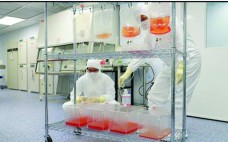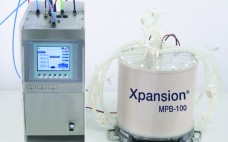As this special Pall supplement of BioProcess International issue goes to press, progress continues in the field of cell therapy research. The revival of cell (and gene) therapy has been driven by some positive achievements that have occurred over the past decade. Cell therapy products differ in many ways from traditional small-molecular and biologic products. The main difference is that, contrary to traditional biopharmaceutical applications in which cells secrete the product of interest, in cell therapy applications cells are the…
Wednesday, September 16, 2015 Daily Archives
Positioning for Success: An Interview with Mario Philips
On 12 March 2015, BPI met with Mario Philips, president, single-use technologies, at Pall’s Port Washington, NY, facility, to learn about Pall’s reasons for entering the cell therapy market. Also participating in the discussion was Alain Fairbank, director of marketing for cell therapies at Pall Life Sciences. Read the full text of this article in the PDF (Login required).
Meeting Lot-Size Challenges of Manufacturing Adherent Cells for Therapy
Adherent cells such as adult primary cell lines and human multipotent (MSCs) and pluripotent stem cells (hPSCs) present a manufacturing challenge as lot sizes increase from 109 (billions) to 1012 (trillions) cells (1). Typically, manufacturing platforms are good for one log of expansion. So new methods will be required to achieve commercially relevant lot sizes. Traditional two-dimensional culture methods have been used to grow anchorage-dependent cell types. Although such methods are reliable and well defined, they are very labor intensive…
T-Cell Suspension Culture in a 24-Well Microbioreactor: High-Throughput Screening of Operating Conditions
Cell therapy promises revolutionary new therapeutic treatments for cancer and other serious diseases and injuries. For example, T-cell therapy response rates of >50% and durable complete response rates of 20% have been reported in patients with metastatic melanoma who had failed other therapies (1). In another example, sustained remissions of up to a year were achieved among a small group of advanced chronic lymphocytic leukemia patients upon treatment with autologous T-cells expressing an anti-CD19 chimeric antigen receptor (2). Numerous other…
Scaling Up Stem Cells: Moving from Laboratory to Commercial Production with a Single-Use Multiplate Bioreactor
Cell-based products are becoming increasingly important as potential biotherapies. Cell therapy is predicted to have a huge impact on the healthcare sector over the coming decades. Stem cells, in particular, are investigated as potential treatments for a diverse range of applications (such as heart disease and metabolic and inflammatory disorders) in which they might be used to restore lost biological functions. Read the full text of this article in the PDF (Login required).
Expansion and Characterization of Mesenchymal Stem Cells on Pall SoloHill® Microcarriers
Mesenchymal stem cells (MSCs) are self-renewing cells that differentiate into several terminally differentiated cell types. These cells have been isolated from multiple sources such as bone marrow, adipose tissue, peripheral blood, and other adult tissues(1–6). The interest in these cells is that they hold the potential to cure disease and are being pursued in clinical trials. Three emerging fields of interest for stem cells are cell therapy, regenerative medicine and screening of candidate drugs. In many cases, poor correlation between…
Strategies for Microcarrier Culture Optimization
The process of delivering an allogeneic stem-cell therapy to patients requires isolation and expansion of rare tissue-specific stem cells, which are subsequently delivered to individual patients for treatment. One type of cell used for such therapies is commonly known as human mesenchymal stem cells (hMSCs). They have been isolated from a number of tissues: e.g., bone marrow, heart, brain, placenta, and umbilical cord. And they have been shown to be immune-privileged in that hMSCs elicit no graft-versus-host (GvH) response such…
Designing the Most Cost-Effective Manufacturing Strategy for Allogeneic Cell-Based Therapies
Rapid progress is occurring in the field of stem cell therapy research, and increasing numbers of products will begin reaching the market in the near future. But new cell therapy treatments must fit into a competitive and highly regulated healthcare environment. Succeeding in that environment requires alignment between a company’s business model and its manufacturing strategy. Read the full text of this article in the PDF (Login required).
Production of Viral Vectors Using the iCELLis® Fixed-Bed Bioreactor System: Beyond Mesenchymal Stem Cells — Gene-Modified Cell Therapy, Gene Therapy, and Exosomes
In the past few years, the resurgence of cell-based immunotherapies — and, by extension, gene therapies — has accelerated as products move rapidly from academic research laboratories into commercial development. A successful clinical trial by St. Jude Children’s Research and the University College London of a gene therapy for hemophilia B was a seminal translational event (1), as was the licensing of the University of Pennsylvania’s gene-modified chimeric antigen receptor T-cell technology (CAR-T) for leukemia by Novartis (2). CAR-T cells…
Single-Use Bioreactors and Microcarriers: Scalable Technology for Cell-Based Therapies
Cell-based therapies hold promise for treating many acute and chronic diseases (1). Optimism surrounding that therapeutic potential has driven the initiation of multiple clinical trials in pursuit of such treatments. Procedures for preparing these therapeutic agents begin with selective isolation of cells from desired tissues. That is followed by ex vivo expansion of cells of desired phenotype and functionality. Once expanded to acceptable levels, cells are stored to preserve their viability during transportation to treatment facilities. The final step in…










